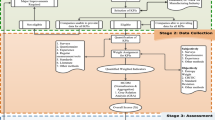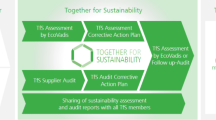Abstract
A sustainability program is about implementing essential sustainability practices at various intensities that will not harm people because of firm actions. This paper formulates an optimization model to identify an optimal intensity of implementation of selected sustainability practices referred as sustainability program for maximising manufacturing industry sustainability performance for a known set of budgetary and minimum thresholds constraints with respect to economic, social and socio-economic criteria. Besides modelling the paper proposes a random search procedure embedding the NN to determine the optimal sustainability program and explains the usefulness with a sample problem. Sensitivity analysis is carried out to understand the behaviour of the model. It is observed that the sustainability performances depend on the constraints such as budget limitation and threshold values of performance criterion.







Similar content being viewed by others
Abbreviations
- B:
-
Budget
- CPI:
-
Composite Performance Index
- E:
-
Economic performance in percentage
- \( it _{max}\) :
-
Maximum iteration
- LR:
-
Learning rate
- MSE:
-
Mean square error
- N:
-
Number of neurons
- S:
-
Social performance in percentage
- SE:
-
Socio-economic performance in percentage
- Z:
-
Overall performance score
- \(Z_{opt}\) :
-
Optimal performance
- \(B_{max}\) :
-
Maximum budgetary limit
- \( CPI _j\) :
-
Composite Performance Index (industry wise)
- \( CPI _j^{A}\) :
-
CPI score of jth industry derived with MADM approach
- \( CPI _j^{E}\) :
-
CPI score of jth industry predicted through NN Model
- \(C_{m_p}\) :
-
Operational cost of pth sustainable practice to its mode m
- \(E_{\mathrm{min}}\) :
-
Minimum threshold of economic performance in percentage
- i:
-
Performance dimension
- I:
-
Number of performance dimensions
- it:
-
Initial iteration
- j:
-
Industry identifier (alternative)
- J:
-
No. of industries
- m:
-
Modes
- M:
-
Number of modes
- p:
-
Practices
- P:
-
Number of practices
- \( PWP _{ij}^A\) :
-
Actual percent weighted performance ith dimension of jth industry
- \( PWP _{ij}^E\) :
-
Estimated percent weighted performance ith dimension of jth industry
- \( SE _{\mathrm{min}}\) :
-
Minimum threshold of socio-economic performance in percentage
- \(S_i^k\) :
-
Performance score for ith dimension to its kth level
- \(S_{m_p}^i\) :
-
Performance scores for sustainable program,
- \(S_j^i\) :
-
Performance score for jth industry to ith dimension
- \(S_{\mathrm{min}}\) :
-
Minimum threshold of social performance in percentage
- \(W_i\) :
-
Weights of criterion
- \(X_{m_p}^{Opt}\) :
-
Optimal sustainable program
- \(X_{m_{p}}\) :
-
Binary variable
References
Alshamrani, O. S., Galal, K., & Alkass, S. (2014). Integrated LCAeLEED sustainability assessment model for structure and envelope systems of school buildings. Building and Environment, 80, 61–70.
Bouchery, Y., Ghaffari, A., Jemai, Z., & Dallery, Y. (2012). Including sustainability criteria into inventory models. European Journal of Operational Research, 222, 229–240.
Chan, J. W. K., & Tong, T. K. L. (2007). Multi-criteria material selections and end-of-life product strategy: Grey relational analysis approach. Materials and Design, 28, 1539–1546.
Chinchuluun, A., & Pardalos, P. M. (2007). A survey of recent developments in multi-objective optimization. Annals of Operations Research, 154, 29–50.
Choi, T. (2014). Sustainable management of mining operations with accidents: A mean-variance optimization model. Resources Policy. doi:10.1016/j.resourpol.2014.02.003.
Curkovic, S. (2003). Environmentally responsible manufacturing: The development and validation of a measurement model. European Journal of Operational Research, 146, 130–155.
Delmas, M. (2001). Stakeholders and competitive advantage: The case of ISO 14001. Journal of Production and Operations Management, 10(3), 343–358.
Ding, Y., Feng, Q., Wang, T., & Fu, X. (2014). A modular neural network architecture with concept. Neurocomputing, 125, 3–6.
Faulkner, W., & Badurdeen, F. (2014). Sustainable value stream mapping (Sus-VSM): Methodology to visualize and assess manufacturing sustainability performance. doi:10.1016/j.jclepro.2014.05.042.
Florez, L., & Castro-Lacouture, D. (2013). Optimization model for sustainable materials selection using objective and subjective factors. Materials and Design, 46, 310–321.
Govindan, K., Jafarian, A., Khodaverdi, R., & Devika, K. (2014). Two-echelon multiple-vehicle location-routing problem with time windows for optimization of sustainable supply chain network of perishable food. International Journal of Production Economics, 152, 9–28.
Jayal, A. D., Badurdeen, F., Dillon, O. W., & Jawahir, I. S. (2010). Sustainable manufacturing: Modeling and optimization challenges at the product, process and system levels. CIRP Journal of Manufacturing Science and Technology, 2, 144–152.
Kates, R. W., Clark, W. C., Corell, R., Hall, M. J., Jaeger, C. C., Lowe, I., et al. (2001). Sustainability science. Science, 292, 641–642.
Khan, M. N. A. (2012). Performance analysis of Bayesian networks and neural networks in classification of file system activities. Journal of Computers and Security, 31, 391–401.
Klassen, R. D., & McLaughlin, C. P. (1996). The impact of environmental management on firm performance. Informs a Journal of The Institute for Operations Research and the Management Sciences, 42, 1199–1214.
Kuik, O. J., & Gilbert, A. J. (1999). Indicators of sustainable development. In J. C. J. M. Van den Bergh (Ed.), Handbook of Environmental and Resource Economics (pp. 722–730). Cheltenham: Edward Elgar.
Linke, B. S., Corman, G. J., Dornfeld, D. A., & Tönissen, S. (2013). Sustainability indicators for discrete manufacturing processes applied to grinding technology. Journal of Manufacturing Systems, 32, 556–563.
López-Villarreal, F., Lira-BarragánL, F., Rico-Ramirez, V., María Ponce-Ortega, J., & El-Halwagi, M. M. (2014). An MFA optimization approach for pollution trading considering the sustainability of the surrounded watersheds. Computers and Chemical Engineering, 63, 140–151.
Montabon, F., Sroufe, R., & Narasimhan, R. (2007). An examination of corporate reporting, environmental management practices and firm performance. Journal of Operations Management, 25(5), 998–1014.
Nahorski, Z. & Ravn, H.F. (2000). A review of mathematical models in economic environmental problems. Annals of Operations Research, 97, 165–201.
Nidumolu, R., Prahalad, C. K., & Rangaswami, M. R. (2009). Why sustainability is now the key driver of innovation. Harvard Business Review, 87, 57–64.
Pandian, G. S., Jawahar, N., & Nachiappan, S. P. (2013). Composite performance index for sustainability. IOSR Journal of Environmental Science, Toxicology and Food Technology, 3(1), 91–102.
Pandian, G. S., Jawahar, N., & Nachiappan, S. P. (2013). Questionnaire for the development of Environmental Regulation Management System for Indian Manufacturing Industries. Management Arts-Elixir International Journal, 56, 13330–13343.
Park, J. J. (1993). Neural Network Processing of Linguistic Symbols Using Multi-Level Grading Rule. Computer Science. Tallahasse, FL, USA: Florida State University.
Rho, B. H., Park, K., & Yu, Y. (2001). An international comparison of the select of manufacturing strategy-implementation gap on business performance. International journal of Production Economics, 70, 89–97.
Roberts, S. J. F., & Ball, P. D. (2014). Developing a library of sustainable manufacturing practices. Procedia CIRP, 15, 159–164.
Rouhani, S., & Ravasan, A. Z. (2013). ERP success prediction: An artificial neural network approach. Scientia Iranica, 20(3), 992–1001.
Saaty, T.L. (1980). The analytic hierarchy process. New York: McGraw Hill. International, Translated to Russian, Portuguese, and Chinese, Revised editions, Paperback. (1996, 2000). Pittsburgh: RWS Publications.
Sarangi, P. P., Sahu, A., & Panda, M. (2013). A hybrid differential evolution and back-propagation algorithm for feedforward neural network training. International Journal of Computer Applications, 84(14), 1–9.
Sezen, B., & Cankaya, S. Y. (2013). Effects of green manufacturing and eco-innovation on sustainability performance. Procedia-Social and Behavioral Sciences, 99, 154–163.
Singh, L. P., Bhardwaj, A., & Sachdeva, A. (2006). Quality management practices vs. performance of SMEs: An empirical study of Indian industries. Journal of Technology Management for the Global Future, 5, 2393–2399.
Subramanian, N., Abdulrahman, M. D., & Rahman, S. (2014). Sourcing complexity factors on contractual relationship: Chinese suppliers’ perspective. Production and Manufacturing Research: An Open Access Journal, 2(1), 558–585.
Triantaphyllou, E., & Mann, S. H. (1995). Using the hierarchy process for decision making in engineering applications: Some challenges. Industrial Engineering Applications and Practice, 2(1), 35–44.
Yang, C. L., Lin, S., Chan, Y., & Sheu, C. (2010). Mediated effect of environmental management on manufacturing competitiveness: An empirical study. International Journal of Production Economics, 123, 210–220.
Zhang, Q., Shah, N., Wassick, J., Helling, R., & Van Egerschot, P. (2014). Sustainable supply chain optimisation: An industrial case study. Computers and Industrial Engineering, 74, 68–83.
Author information
Authors and Affiliations
Corresponding author
Appendix: survey instrument
Appendix: survey instrument
See Tables 14, 15, 16, 17, 18, 19.
Respondent’s details

Rights and permissions
About this article
Cite this article
Jawahar, N., Satish Pandian, G., Gunasekaran, A. et al. An Optimization Model for Sustainability Program. Ann Oper Res 250, 389–425 (2017). https://doi.org/10.1007/s10479-015-1928-z
Published:
Issue Date:
DOI: https://doi.org/10.1007/s10479-015-1928-z




